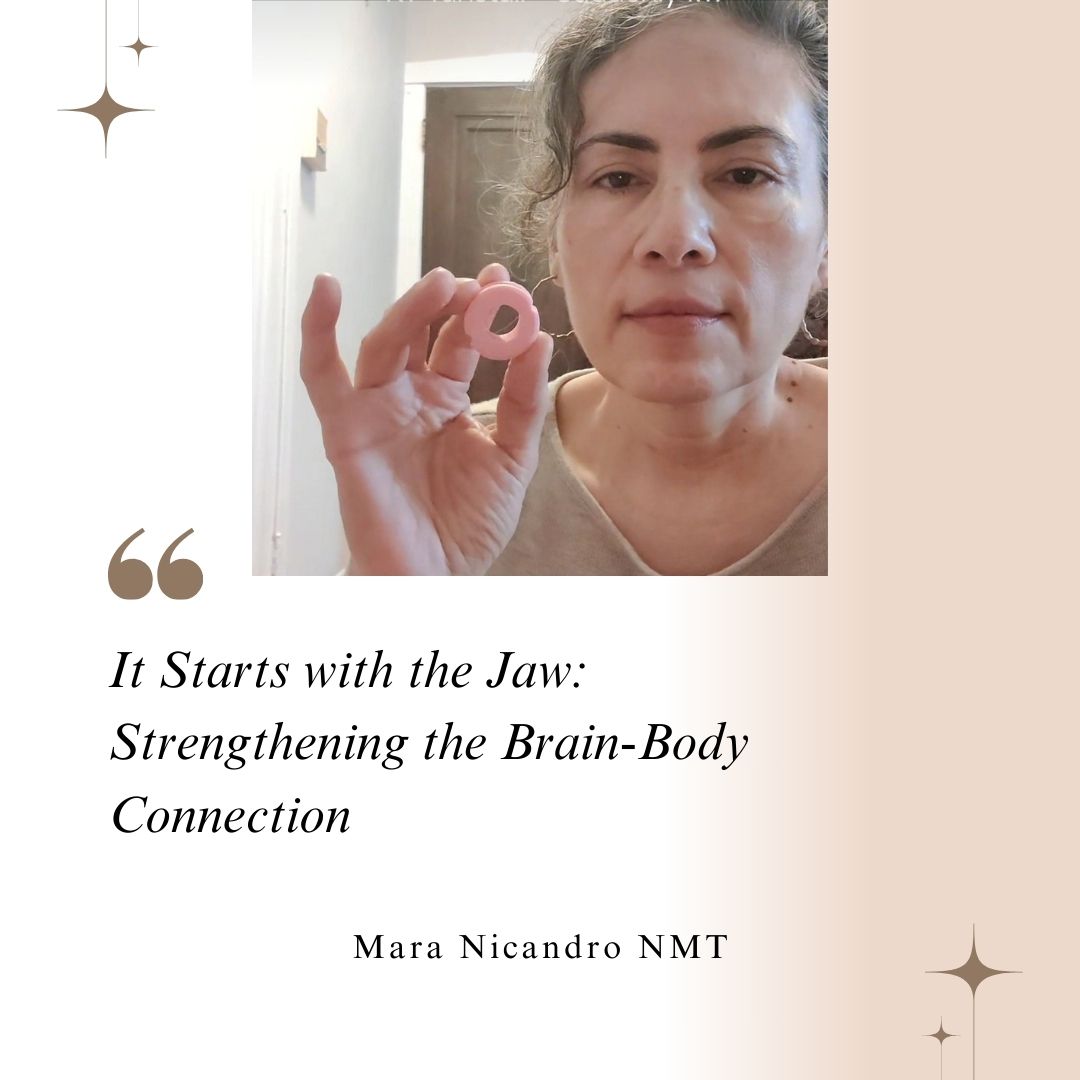Compensations in the body don’t just affect how we move—they also place stress on the brain. Whether it’s forward head posture, jaw tension, or shallow breathing, these seemingly isolated issues can disrupt the brain-body connection, making movement feel harder and creating cycles of discomfort.
This concept is explored in greater depth in Your Body’s Natural Stack™: Rediscover Balance Through Breath and Alignment, where the focus is on how small, intentional changes in alignment can create lasting improvements in movement, resilience, and overall well-being.
By focusing on tools and techniques that support proper alignment, natural stacking, and mindful breathing, we can restore our body’s natural flow and strengthen the brain-body connection. It all starts with the jaw.
The Jaw: A Starting Point for Alignment
Your jaw plays a critical role in how your body stacks naturally. Proper alignment of the jaw helps keep your head balanced over your spine, creating a foundation for efficient movement.
When the jaw is tense or misaligned, it can create a domino effect:
- Neck Misalignment: Tension in the jaw pulls on the neck, leading to forward head posture. Research indicates that jaw tension can directly influence cervical spine alignment and contribute to muscular strain. (Source: Journal of Oral Rehabilitation, 2016)
- Breathing Disruption: Jaw tension can compress the phrenic nerve, which controls the diaphragm, resulting in shallow breathing. Studies have shown that poor neck alignment impacts diaphragmatic efficiency, reducing oxygen flow and contributing to fatigue. (Source: Journal of Applied Physiology, 2009)
- Cognitive Strain: The brain must work harder to compensate for misalignments, reducing mental clarity and resilience.
The Brain-Body Connection: How Compensations Affect Your Health
Compensations in the body disrupt the feedback loop between your brain and muscles. Research shows that postural misalignments increase proprioceptive demands on the brain, leading to heightened stress on the nervous system. (Source: Neuroscience Letters, 2014)
When alignment is off, the brain receives conflicting signals, which can lead to:
- Overuse of secondary muscles, like the shoulders and chest, to assist breathing.
- Increased tension throughout the body, contributing to fatigue and mental fog.
- Stress on the nervous system, reducing focus and overall resilience.
Tools like bite wheels, toe separators, and single-leg stance exercises activate sensory pathways in the jaw and feet, helping the brain recalibrate and recognize efficient movement patterns.
Anna’s Story: A Journey to Alignment
Anna came to me with persistent discomfort—a feeling of fullness in her throat, clogged ears, and difficulty hearing clearly. Through assessment, we discovered tension patterns in her hyoid bone, a small U-shaped bone in the neck that anchors muscles in the jaw, tongue, and throat.
These imbalances extended through her entire body, leading to:
- Morning puffiness from restricted lymphatic drainage. (Source: Lymphatic Research and Biology, 2021)
- Throat tightness and jaw tension.
- Poor alignment and compensatory walking patterns.
Using tools like a bite wheel and single-leg stance exercises, we worked on releasing tension, restoring natural stacking, and improving her brain-body connection. Over time, Anna experienced relief from her symptoms, improved hearing, and a stronger sense of balance.
Breaking the Cycle: Tools and Techniques
Intentional movements and simple tools can help reduce compensations, improve alignment, and strengthen the connection between your brain and body:
- Bite Wheel for Jaw Alignment: Retrains the masseter muscles and reduces clenching.
- Toe Separators: Activate sensory pathways in the feet to promote natural movement.
- Single-Leg Stance: Reveals compensatory patterns and encourages natural stacking.
- Cooling Breath: Promotes deep, diaphragmatic breathing, calming the nervous system and improving oxygen flow.
Takeaways for Supporting Your Brain-Body Connection
Anna’s story and these techniques highlight the importance of checking in with your body regularly. Here’s how to start:
- Notice Your Posture: Is your head aligned over your spine?
- Relax Your Jaw: Practice unclenching throughout the day.
- Focus on Breathing: Use deep, diaphragmatic breaths to reduce tension and support brain function.
- Tune Into Alignment: Try single-leg stance exercises to strengthen balance and uncover compensatory patterns.
Conclusion
Health is more than the absence of pain. It’s about creating alignment, reducing compensations, and restoring the natural flow between your brain and body. By focusing on tools and techniques that support alignment and balance, you can build a foundation for strength, resilience, and ease in your everyday life.
What’s one way you’re supporting your brain-body connection today?
Health is more than the absence of pain. It’s about creating alignment, reducing compensations, and restoring the natural flow between your brain and body. By focusing on tools and techniques that support alignment and balance, you can build a foundation for strength, resilience, and ease in your everyday life.
Want to see these techniques in action? Check out my video where I demonstrate how I use a bite wheel, toe separators, and single-leg stance to check in with my body and strengthen the brain-body connection.

